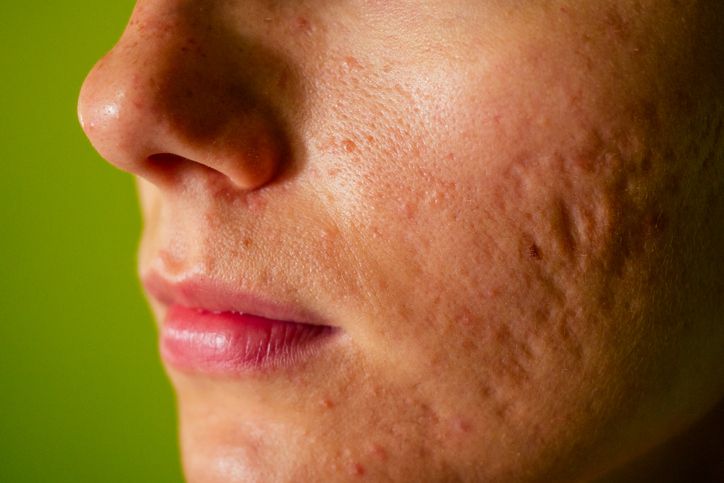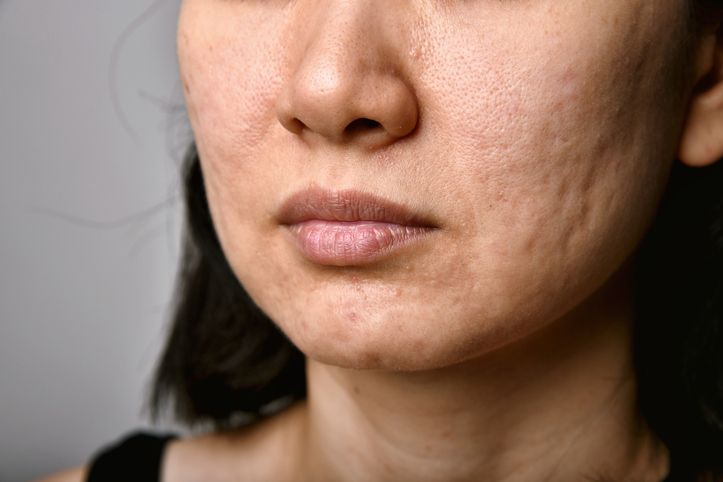- Home
- Trend
- Weight Loss Strategies
- Acne Tips
- Hair Health Information
- Blemish Removal Tips
- Acne Scar Removal Tips
- Muscle Building Techniques
- Intimate Care Tips
- Postpartum Intimate Care
- Eye Bags Wiki
- Tips for Face Slimming
- Secret of Permanent Hair Removal
- Breast Enlargement Tips
- Cure to Snoring
- Marionette Lines
- Skin-Tightening Secrets
Nothing is more frustrating than developing deep pitted acne scars after a breakout. While typical acne marks fade over time, pitted scars are a bigger headache—they don’t go away on their own and can leave your skin looking cratered like the moon’s surface. But does that mean there’s no solution? Not at all! Want to know the best ways to treat acne scars? Read on!
What Are Acne Scars (Pitted Scars)?

Pitted scars refer to indentations or raised marks on the skin caused by acne. These scars are typically more severe and harder to fade than ordinary blemishes. They form when deep, inflamed acne damages the dermis. The skin’s ability to self-repair becomes compromised, often leading to fibrous adhesions. As a result, collagen loss causes the skin to sink in, forming permanent indentations.
Although difficult to treat, pitted scars aren’t untreatable. There's a "golden” treatment period—within one year of their formation. If addressed with the right method during this time, they may still be reversed. However, once that window passes, the scars can become permanent and significantly harder to improve.
The 3 Most Common Types of Pitted Scars
i. Ice Pick Scars
Also known as conical or V-shaped scars, they are narrow (less than 2 mm wide) but deep, sometimes reaching the dermis. These are the hardest to treat due to their depth.
ii. Boxcar Scars
These appear as round or oval depressions with steep sides and a flat base. Their widths range from 1 to 1.5 mm, and they create a distinct edge where the scar meets normal skin.
iii. Rolling Scars
Viewed from the side, these look like waves or wheel marks—wide, shallow depressions without clear borders. Though they can be up to 4 mm wide, they’re closer to the surface and easier to treat.
The 4 Main Causes of Pitted Scars

i. Recurrent Acne in the Same Area
Repeated inflammation in one spot damages collagen in the dermis. As the skin undergoes repeated cycles of injury and healing, fibrous tissue forms, and the area collapses, leaving a crater-like scar.
ii. Squeezing Pimples
Trying to pop pimples—especially before they’re fully mature—can worsen inflammation in the dermis. This trauma damages skin tissue, increases infection risk (especially with unclean hands), and heightens the chance of scarring.
iii. Improper Extraction
Manual extraction using acne tools can speed up healing, but if done incorrectly or too aggressively, it can severely damage skin tissue. This disrupts the collagen structure, forming scar depressions.
iv. Poor Skincare Habits
Over-controlling oil can lead to dryness, slowing the skin’s repair function. Dehydrated skin heals poorly and becomes prone to inflammation, increasing scarring risk. A balanced skincare routine is essential.
免費體驗
Acne Treatment
1 Minute Self-Registration
Date should not be before minimal date
5 Effective Acne Scar Treatments for Acne-Prone Skin
i. Glycolic Acid Peels (AHA Treatments)
Derived from fruits or vegetables (e.g. citric acid, mandelic acid), AHAs penetrate deeply to promote skin turnover and unclog pores. They also stimulate collagen production to smooth scars. However, these peels can be irritating—causing redness, itching, and peeling—making them unsuitable for sensitive skin.
ii. Microneedling Treatments
This “controlled injury” technique uses micro-needles to create tiny channels in the skin, stimulating collagen production and self-repair. Home microneedling kits are available, but improper use can cause infections. It’s best done by professionals.
iii. Hyaluronic Acid Fillers
Hyaluronic acid is a natural polysaccharide that hydrates and plumps skin. Injecting it into depressed scars helps lift the sunken areas, smoothing the surface. However, it's not effective on all areas (e.g., nose scars), and results are temporary as the body metabolizes the filler.
iv. Picosecond Laser Treatments
These lasers use ultra-short pulses to penetrate various skin layers and trigger collagen regeneration. They can improve scars, reduce pigmentation, and shrink pores. Picosecond lasers are versatile and widely used in medical aesthetics.
v. Radiofrequency (RF) Treatments
RF energy converts to heat, stimulating dermal collagen production and remodeling. This helps fill in depressions and smooth out the skin. Side effects like redness and swelling can last 1–3 days. Fractional RF is gentler and safer but may yield milder results compared to monopolar RF.
4 Simple Daily Habits to Improve Acne Scars Naturally
i. Exfoliate Regularly
Exfoliating helps remove dead skin cells, prevent breakouts, and enhance the effectiveness of acne scar treatments by allowing nutrients to penetrate deeper.
ii. Hydrate and Moisturize
Skin repair relies on adequate hydration. Dry skin heals poorly, making it prone to scarring. Use hydrating skincare products to support regeneration.
iii. Take Collagen Supplements
Lack of collagen is a key reason for acne scar formation. Boosting your collagen intake improves skin elasticity and overall texture. Collagen-rich foods and drinks can help.
iv. Reduce Sugar Intake
Sugar binds with proteins in the body to form advanced glycation end-products (AGEs), which damage collagen and worsen inflammation. Cut back on sugary foods like cake, candy, and soda to help your skin heal better and reduce scarring.
Perfect Medical Acne Treatment for Scars: Fast and Effective Smoothing Without Irritation
Acne scars are difficult to treat, and many aesthetic procedures carry a risk of irritation or allergic reactions. That’s why Perfect Medical’s Acne Treatment offers a safe and effective alternative. It not only fades existing scars but also helps prevent future breakouts by targeting the root cause of scarring.
The Acne Treatment uses advanced dual-spiral suction and drainage technology. One channel provides deep cleansing to the skin, gently and painlessly removing surface oil, dirt, and dead skin cells. This helps unclog pores and enhances the skin’s ability to absorb nutrients. Meanwhile, the second channel delivers a medically developed serum deep into the skin to reactivate collagen production, stimulate the regeneration of collagen, and repair damaged skin tissue—effectively reducing acne marks, indentations, and raised scars.
Right now, Perfect Medical is offering a free trial of the Acne Treatment. Simply click the link below to book your appointment. If you're interested, don’t miss out!
Free Trial: Perfect Medical Acne Treatment免費體驗
Acne Treatment
1 Minute Self-Registration
Date should not be before minimal date
FAQ

Can acne scars with indentations be eliminated?
Indented acne scars refer to depressions or raised marks left on the skin’s surface. Although they are more difficult to treat, they’re not untreatable. The golden treatment window for indented scars is within one year of their formation. In other words, if treated correctly within that first year, there is a good chance they can be reduced or eliminated.
What causes indented acne scars?
Common causes include recurring breakouts in the same area, squeezing pimples by hand, or improper extraction techniques. These actions can aggravate skin inflammation and cause severe tissue damage, preventing proper healing. As a result, indented scars may develop.
What are the treatment options for indented scars?
Effective treatments include picosecond laser therapy, chemical peels (such as glycolic acid), radiofrequency treatments, and microneedling. However, these procedures can be irritating to the skin, so it’s essential to consult a professional beforehand—especially for those with sensitive skin.
Can Perfect Medical’s Acne Treatment help with indented scars?
Yes, Perfect Medical’s Acne Treatment not only fades indented scars but also helps prevent new acne from forming—targeting the root cause to reduce the likelihood of future scarring. The treatment deeply cleanses the skin to unclog pores and boost nutrient absorption. At the same time, it delivers a medical-grade serum deep into the skin to stimulate collagen production and repair damaged tissue—achieving visible improvements in acne marks and indented scars.
Is the Acne Treatment suitable for sensitive skin?
Absolutely. The Acne Treatment uses entirely non-invasive techniques that are gentle and free from harsh irritation. It’s a safe and comfortable option, even for those with sensitive skin.









